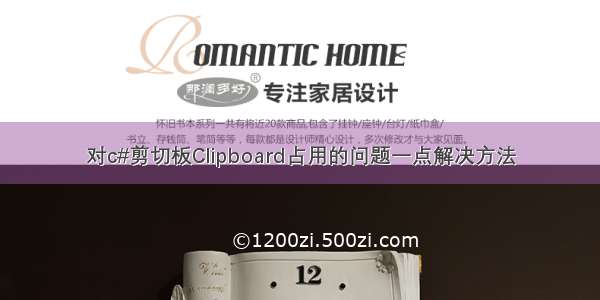
前言:
最近正好写一个程序,需要操作剪切板
功能很简单,只需要从剪切板内读取字符串,然后清空剪切板,然后再把字符串导入剪切板
我想当然的使用我最拿手的C#来完成这项工作,原因无他,因为.Net框架封装了能实现这种功能的方法
然后就有了如下代码
1 string Temp = ""; 2 while (true) 3 { 4 string Tex = Clipboard.GetText().ToString(); 5 if (!string.IsNullOrWhiteSpace(Tex) && Temp != Tex) 6 { 7 Clipboard.Clear(); 8 Clipboard.SetDataObject(Tex, false); 9 Temp = Tex;10 }11 Thread.Sleep(1);12 }
View Code
这段代码,也是网页上广泛流传的,使用.Net框架操作系统剪切板的方法,当然这个方法在某些情况下很管用
不过在我这确发生了点问题,主要的问题有两点
首先,我对剪切板的操作需求有实时性,也就是,操作人员复制的一瞬间就应该截取到剪切板的数据,处理完后再放入剪切板
结果
Clipboard.SetDataObject(Tex, false);
没想到上面这条设置剪切板的指令竟然会卡焦点窗口的线程,比如说,我在A软件执行了一次复制操作,如果使用了上述代码,那么A软件强制线程堵塞大概几百毫秒的样子,反正很影响体验,我推测是因为该命令会锁定内存导致的
那怎么办,本着死马当活马医的态度,我专门为该指令启用了一个线程
Task.Factory.StartNew(()=> {Clipboard.Clear();Clipboard.SetDataObject(Text, false);});
使用了线程以后,因为操作滞后(线程启动会延迟一会儿,并不实时)了,所以上述问题似乎解决了,但是没想到出现了新的问题
string Tex = Clipboard.GetText().ToString();
上述从剪切板获得字符串的指令,在默写情况下,会卡滞住,然后程序在一分钟之后,因为超时而被系统吊销
emmmmm,在经过几番努力之后,我终于意识到,虽然.Net封装了不少操作系统API的方法,使得一些IO操作变简单不少,但是带来的问题也是同样大的,在遇到无法解决的问题的时候,会有点束手无策
于是不得已,我只能放弃使用过C#完成该项功能,想着幸好功能简单,而且操作WinAPI其实最好的还是使用C++来写,于是我用C++复现了上述功能
1 #include "stdafx.h" 2 #include <windows.h> 3 #include <iostream> 4 using namespace std; 5 #pragma comment(linker,"/subsystem:windows /entry:mainCRTStartup") 6 7 int main(int argc, _TCHAR* argv[]) 8 { 9HANDLE THandle = GlobalAlloc(GMEM_FIXED, 1000);//分配内存10char* Temp = (char*)THandle;//锁定内存,返回申请内存的首地址11while (true)12{13 HWND hWnd = NULL;14 OpenClipboard(hWnd);//打开剪切板15 if (IsClipboardFormatAvailable(CF_TEXT))16 {17 HANDLE h = GetClipboardData(CF_TEXT);//获取剪切板数据18 char* p = (char*)GlobalLock(h);19 GlobalUnlock(h);20 if (strcmp(Temp, p))21 {22 EmptyClipboard();//清空剪切板23 HANDLE hHandle = GlobalAlloc(GMEM_FIXED, 1000);//分配内存24 char* pData = (char*)GlobalLock(hHandle);//锁定内存,返回申请内存的首地址25 strcpy(pData, p);26 strcpy(Temp, p);27 SetClipboardData(CF_TEXT, hHandle);//设置剪切板数据28 GlobalUnlock(hHandle);//解除锁定29 }30 }31 CloseClipboard();//关闭剪切板32 Sleep(500);33}34return 0;35 }
View Code
不愧是C++,使用上述代码后,完美实现我需要的功能,而且不管是主程序,还是我写的这个程序,都不会出现卡滞或者不工作的情况了,真是可喜可贺。
那么本教程就到此为止。
以下是正文
想着,既然我能用C++调用WinAPI完美实现我需要的功能,而且C#也能调用非托管的代码来执行WinAPI,那么我不是可以把上面C++写的代码移植到C#里面执行?说干就干
首先,C#调用WinAPI需要先申明
[DllImport("User32")]internal static extern bool OpenClipboard(IntPtr hWndNewOwner);[DllImport("User32")]internal static extern bool CloseClipboard();[DllImport("User32")]internal static extern bool EmptyClipboard();[DllImport("User32")]internal static extern bool IsClipboardFormatAvailable(int format);[DllImport("User32")]internal static extern IntPtr GetClipboardData(int uFormat);[DllImport("User32", CharSet = CharSet.Unicode)]internal static extern IntPtr SetClipboardData(int uFormat, IntPtr hMem);
操作剪切板需要调用的API大致就上面这些
有了API以后,我们还需要自己手动封装方法
internal static void SetText(string text){if (!OpenClipboard(IntPtr.Zero))
{
SetText(text);
return;
}EmptyClipboard();SetClipboardData(13, Marshal.StringToHGlobalUni(text));CloseClipboard();}internal static string GetText(int format){string value = string.Empty;OpenClipboard(IntPtr.Zero);if (IsClipboardFormatAvailable(format)){IntPtr ptr = NativeMethods.GetClipboardData(format);if (ptr != IntPtr.Zero){value = Marshal.PtrToStringUni(ptr);}}CloseClipboard();return value;}
我们也就用到两个方法,从剪切板获得文本和设置文本到剪切板,哦关于SetClipboardData的第一个参数13是怎么来的问题,其实这个剪切板的格式参数,下面有一张表,就是自从这里来的
public static class ClipboardFormat{/// <summary>/// Text format. Each line ends with a carriage return/linefeed (CR-LF) combination. A null character signals/// the end of the data. Use this format for ANSI text./// </summary>public const int CF_TEXT = 1;/// <summary>/// A handle to a bitmap (<c>HBITMAP</c>)./// </summary>public const int CF_BITMAP = 2;/// <summary>/// Handle to a metafile picture format as defined by the <c>METAFILEPICT</c> structure. When passing a/// <c>CF_METAFILEPICT</c> handle by means of DDE, the application responsible for deleting <c>hMem</c> should/// also free the metafile referred to by the <c>CF_METAFILEPICT</c> handle./// </summary>public const int CF_METAFILEPICT = 3;/// <summary>/// Microsoft Symbolic Link (SYLK) format./// </summary>public const int CF_SYLK = 4;/// <summary>/// Software Arts' Data Interchange Format./// </summary>public const int CF_DIF = 5;/// <summary>/// Tagged-image file format./// </summary>public const int CF_TIFF = 6;/// <summary>/// Text format containing characters in the OEM character set. Each line ends with a carriage return/linefeed/// (CR-LF) combination. A null character signals the end of the data./// </summary>public const int CF_OEMTEXT = 7;/// <summary>/// A memory object containing a <c>BITMAPINFO</c> structure followed by the bitmap bits./// </summary>public const int CF_DIB = 8;/// <summary>/// Handle to a color palette. Whenever an application places data in the clipboard that depends on or assumes/// a color palette, it should place the palette on the clipboard as well. If the clipboard contains data in/// the <see cref="CF_PALETTE"/> (logical color palette) format, the application should use the/// <c>SelectPalette</c> and <c>RealizePalette</c> functions to realize (compare) any other data in the/// clipboard against that logical palette. When displaying clipboard data, the clipboard always uses as its/// current palette any object on the clipboard that is in the <c>CF_PALETTE</c> format./// </summary>public const int CF_PALETTE = 9;/// <summary>/// Data for the pen extensions to the Microsoft Windows for Pen Computing./// </summary>public const int CF_PENDATA = 10;/// <summary>/// Represents audio data more complex than can be represented in a CF_WAVE standard wave format./// </summary>public const int CF_RIFF = 11;/// <summary>/// Represents audio data in one of the standard wave formats, such as 11 kHz or 22 kHz PCM./// </summary>public const int CF_WAVE = 12;/// <summary>/// Unicode text format. Each line ends with a carriage return/linefeed (CR-LF) combination. A null character/// signals the end of the data./// </summary>public const int CF_UNICODETEXT = 13;/// <summary>/// A handle to an enhanced metafile (<c>HENHMETAFILE</c>)./// </summary>public const int CF_ENHMETAFILE = 14;/// <summary>/// A handle to type <c>HDROP</c> that identifies a list of files. An application can retrieve information/// about the files by passing the handle to the <c>DragQueryFile</c> function./// </summary>public const int CF_HDROP = 15;/// <summary>/// The data is a handle to the locale identifier associated with text in the clipboard. When you close the/// clipboard, if it contains <c>CF_TEXT</c> data but no <c>CF_LOCALE</c> data, the system automatically sets/// the <c>CF_LOCALE</c> format to the current input language. You can use the <c>CF_LOCALE</c> format to/// associate a different locale with the clipboard text./// An application that pastes text from the clipboard can retrieve this format to determine which character/// set was used to generate the text./// Note that the clipboard does not support plain text in multiple character sets. To achieve this, use a/// formatted text data type such as RTF instead. /// The system uses the code page associated with <c>CF_LOCALE</c> to implicitly convert from/// <see cref="CF_TEXT"/> to <see cref="CF_UNICODETEXT"/>. Therefore, the correct code page table is used for/// the conversion./// </summary>public const int CF_LOCALE = 16;/// <summary>/// A memory object containing a <c>BITMAPV5HEADER</c> structure followed by the bitmap color space/// information and the bitmap bits./// </summary>public const int CF_DIBV5 = 17;/// <summary>/// Owner-display format. The clipboard owner must display and update the clipboard viewer window, and receive/// the <see cref="ClipboardMessages.WM_ASKCBFORMATNAME"/>, <see cref="ClipboardMessages.WM_HSCROLLCLIPBOARD"/>,/// <see cref="ClipboardMessages.WM_PAINTCLIPBOARD"/>, <see cref="ClipboardMessages.WM_SIZECLIPBOARD"/>, and/// <see cref="ClipboardMessages.WM_VSCROLLCLIPBOARD"/> messages. The <c>hMem</c> parameter must be <c>null</c>./// </summary>public const int CF_OWNERDISPLAY = 0x0080;/// <summary>/// Text display format associated with a private format. The <c>hMem</c> parameter must be a handle to data/// that can be displayed in text format in lieu of the privately formatted data./// </summary>public const int CF_DSPTEXT = 0x0081;/// <summary>/// Bitmap display format associated with a private format. The <c>hMem</c> parameter must be a handle to/// data that can be displayed in bitmap format in lieu of the privately formatted data./// </summary>public const int CF_DSPBITMAP = 0x0082;/// <summary>/// Metafile-picture display format associated with a private format. The <c>hMem</c> parameter must be a/// handle to data that can be displayed in metafile-picture format in lieu of the privately formatted data./// </summary>public const int CF_DSPMETAFILEPICT = 0x0083;/// <summary>/// Enhanced metafile display format associated with a private format. The <c>hMem</c> parameter must be a/// handle to data that can be displayed in enhanced metafile format in lieu of the privately formatted data./// </summary>public const int CF_DSPENHMETAFILE = 0x008E;/// <summary>/// Start of a range of integer values for application-defined GDI object clipboard formats. The end of the/// range is <see cref="CF_GDIOBJLAST"/>. Handles associated with clipboard formats in this range are not/// automatically deleted using the <c>GlobalFree</c> function when the clipboard is emptied. Also, when using/// values in this range, the <c>hMem</c> parameter is not a handle to a GDI object, but is a handle allocated/// by the <c>GlobalAlloc</c> function with the <c>GMEM_MOVEABLE</c> flag./// </summary>public const int CF_GDIOBJFIRST = 0x0300;/// <summary>/// See <see cref="CF_GDIOBJFIRST"/>./// </summary>public const int CF_GDIOBJLAST = 0x03FF;/// <summary>/// Start of a range of integer values for private clipboard formats. The range ends with/// <see cref="CF_PRIVATELAST"/>. Handles associated with private clipboard formats are not freed/// automatically; the clipboard owner must free such handles, typically in response to the/// <see cref="ClipboardMessages.WM_DESTROYCLIPBOARD"/> message./// </summary>public const int CF_PRIVATEFIRST = 0x0200;/// <summary>/// See <see cref="CF_PRIVATEFIRST"/>./// </summary>public const int CF_PRIVATELAST = 0x02FF;}
View Code
在C++里面是不用指定数字的,只需要用CF_UNICODETEXT就行,不过.Net里面应该没有对应的索引表,所以只能手动输入(我这里是为了说明用才专门用数字,自己代码那是索引的枚举类)
上面两个工作做完以后,就能实现功能了,功能代码如下
var LastS = string.Empty;while (!CancelInfoClipboard.IsCancellationRequested){var Temp = ClipboardControl.GetText(ClipboardFormat.CF_UNICODETEXT);if (!string.IsNullOrEmpty(Temp) && Temp != LastS){ClipboardControl.SetText(Temp);LastS = Temp;}Thread.Sleep(50);}
是不是和最开始展示的调用.Net框架的方法一模一样(笑),不过使用底层API实现的功能,就没有那么多乱七八糟的Bug了,自己也很清楚到底实现了啥功能,同时也收获了不少新知识(主要是非托管代码调用的时候的注意事项什么的,还有,向非托管代码传递数据的时候,最好多用Marshal类里面的方法,不然可能会出错,毕竟这个类就是专门为非托管代码而设立的)
接下来是新的发现
在研究MSDN上面关于剪切板的API的时候,发现了一个函数
bool AddClipboardFormatListener(HWND hwnd);
根据描述来讲,是添加一个剪切板的监控,在剪切板有任何变动的时候,通知你所指定的句柄的窗口,我一想,这不就是我所需要的么,有了这么一个API以后,其实我上面所展示的,使用死循环轮询剪切板的方法就变得很傻逼,而且也很容易出错了,于是,基于这个新发现的API,我重新更改了全部的程序逻辑,反而比原先的实现更加简单了。
首先我们需要一个新的窗口或者控件来接收Windows消息更新后所发来的消息,只要New 一个form就行
public Form2(){InitializeComponent();AddClipboardFormatListener(this.Handle);}
然后我们在初始化组件的命令后面,把使用添加剪切板监听的API把当前窗口的句柄发给系统,这样系统在接收到剪切板改变的命令后,会把消息发给当前窗口
然后我们需要复写WndProc方法
protected override void WndProc(ref Message m){if (m.Msg == 0x031D && Onice){var Temp = ClipboardControl.GetText(ClipboardFormat.CF_UNICODETEXT);if (!string.IsNullOrEmpty(Temp)){ClipboardControl.SetText(Temp);Onice = false;}}else if (!Onice){Onice = true;}else{base.WndProc(ref m);}}
private bool Onice = true;
首先WndProc如果是Form类下面一个专门用来接收系统发送过来的消息的方法
然后关于m.Msg == 0x031D的0x031D在WinAPI定义上的意义是WM_CLIPBOARDUPDATE ,也就是剪切板更新事件,这个通过查找MSDN能够找到
下面没有特别奇怪的函数,就是有一点需要注意,我们这里设置了剪切板数据,相当于进行了一次更新,所以会在这一瞬间再次产生剪切板更新事件,然后又会通知这个方法,然后就会形成死循环,我在这里用了一个布尔判断来通过布尔状态决定是否截取剪切板,不只有有没有更好的办法来实现
以上














